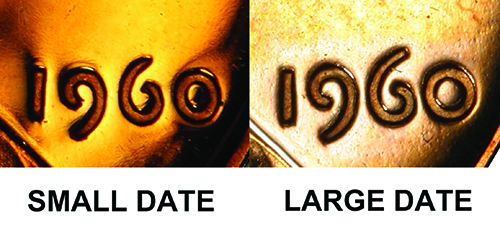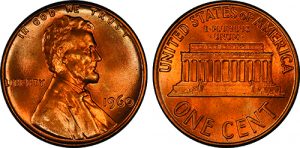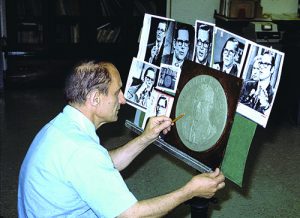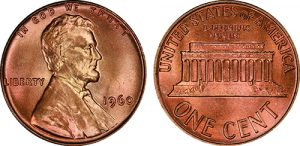
Editor’s Note: This article was awarded the honor of Best Article during the 2017 Numismatic Literary Guild Writers’ Competition.
By Tom DeLorey
About the time that I started collecting coins, around 1960, the U.S. coin market was mesmerized by the concept of collecting and/or hoarding original BU rolls of coins. Being a child of limited means, content with filling Whitman folders, I was not affected personally at the time, but it affected the coin collecting universe greatly, and eventually my life.
I was too young to appreciate the peculiar chain of events that led to the striking of the epicenter of this madness: the 1960-P Small Date cent, which is apparently the lowest-mintage regular-issue U.S. coin since the 1938-D half dollar. Even today, most collectors have no idea why it had an (unofficial) mintage of only 2,075,000 pieces, a mere pittance that the current Philadelphia Mint can turn out in less than an hour. I think I just figured it out.
Examining Small Date Cent Mintage
For many decades before 1960, it was traditional for established coin dealers to put away a roll or two of each new issue for inventory purposes to meet the demand for future single coin sales. Thanks to this practice, the hobby today has many surviving examples of most modern-date coins in Choice BU condition—though, of course, the rolls did not survive as rolls since they were broken up for the single coin sales.
(I have always assumed that certain collectible varieties that involve badly degraded dies such as the 1922 “No-D” cents and the 1937-D “3-Legged” nickels are rare in true Uncirculated condition because the dealers putting away the rolls would have looked at a roll containing such “defective” coins and dumped them back into circulation, finding another roll of well-struck coins for inventory to keep their customers happy.)
New issues such as the 1909 Lincoln cents, the 1913 Buffalo nickels and the 1916 “Mercury” dimes and Walking Liberty halves would have been saved in larger quantities because of the expected demand for the new designs. The 1916 Standing Liberty quarters were not saved in BU rolls because they were struck in very small quantities very late in the year, and ended up getting dumped into the 1917 production and being distributed in mixed-date rolls.
Set Aside or Later Inventories

The 1917-PD&S quarters were instead the ones put aside in rolls as examples of the new-design coinage, and the 1917-P rolls might have helped preserve a few of the 1916 coins mixed into them. The 1921 Peace dollars were likewise struck very late in the calendar year, with the result that few original rolls made it into dealers’ inventories.
This practice held steady throughout the huge mintages of World War II, but afterward a funny thing happened: The manufacturing sector returned to normal, eliminating the need for triple shifts in war-related industries. Payrolls shrank along with the economy, and the need for coins to fill pay envelopes decreased accordingly.
The supply of coins struck during the wartime years (and mostly still in circulation, if not slumbering unneeded in bank vaults) was often sufficient to meet the day-to-day demand for some denominations, and the Denver and San Francisco mints skipped striking some denominations in some years. The mintages of the denominations that were struck were greatly reduced from their wartime highs.
With the Federal Reserve System ordering fewer new coins from the mints, dealers started having trouble getting their BU rolls for inventory. People started paying attention to monthly coinage production figures and hoarding rolls that they thought were going to be scarce. The legitimately scarcer rolls began trading at multiples of their face values.
Hoarding Rolls Continues
The market exploded when the 1950-D nickel showed a total mintage of only 2,630,030 pieces, compared with production at Denver in the 30 million to 40 million range from 1943 to 1949. Dealers who had developed sources in the banking distribution system managed to snap up perhaps half of the total mintage in roll or bag form, and over the next decade drove the price of the rolls up to ten times their face value or more.
During this craze, other BU rolls of the 1950s got hoarded and hyped as “the next big thing.” Any small decrease in mintage was seized upon as an opportunity for speculation, making people think that 71 million was a “low” mintage for the 1954 cent.
When the striking of 1955-S cents and dimes was ended in mid-year with the closing of the San Francisco Mint (because the Treasury Department felt that it had too much coinage capacity!), both were hoarded in huge numbers, along with 1955-P&D dimes just because they were dated 1955. (When I worked at Harlan Berk’s coin shop in Chicago, I remember dumping BU rolls of 1955-P&D dimes that had been saved for over half a century into the junk silver coin counter, because their bullion value was more than their numismatic value.)
As the economy grew in the second half of the 1950s, the correspondingly increased coin production, now divided among only two mints rather than three, seemed to guarantee that there would be no more low mintages. Nevertheless, some promoters seized upon minor downturns (such as happened at Philadelphia in 1958 due to a minor recession) as an excuse to promote the resulting issues. The hoarding of BU rolls continued to increase.
Speculation Over Size Rises
Then all heck broke loose in the spring of 1960 when a collector notified the venerable Numismatic Scrapbook Magazine that he had noticed in his 1960 proof sets two different-sized dates on the cents. It was quickly obvious that earlier in the year, the Mint had changed the size of the date from small to large without telling anybody. Both collectors and dealers quickly ascertained that the uncirculated 1960-P Small Date cent was very hard to come by.

Speculation on the “BU 1960-P SD” rolls skyrocketed, eventually reaching $400 for a 50-cent roll! This was back when $400 would buy you a good used car. Speculation in the 1960 SD proof sets also ran riot, as did speculation in all other modern issues. But why was the 1960 Small Date so rare?
Back then, the mints often worked on coin denominations in batches, partly to meet immediate demand from the Federal Reserve banks and partly for efficiency’s sake, making perhaps cents, dimes and quarters over one several-week period, then just cents and nickels for the next few weeks. The half dollar was seldom struck, while the common cent was struck in most months.
Despite this batch system, it was standard practice for the Philadelphia Mint in the late 1950s to strike approximately 2 million pieces of each denomination in January or February, perhaps so that it could have a small inventory of each on hand for inclusion in Uncirculated coin sets (aka “mint sets) and/or for other purposes. Occasionally, it might strike larger numbers of one or more denomination in January as well, such as happened with the 1959 cent which was in large demand because of the new Lincoln Memorial reverse.
P-Mint Small Date Cents Changes Protocol
Others have pointed out that based upon the monthly production figures released by the Mint, and typically published in The Numismatist about three months after the fact, it seems highly likely that the 2,075,000 cents struck in January 1960 were the only P-mint Small Date cents ever made. However, to the best of my knowledge, nobody has ever given a reason why, after those approximately 2 million pieces of each denomination were struck in January, no U.S. coins at all were struck in Philadelphia for the rest of January or in February, which would have caused the 1960 SD cent to be more common.
(Small Date D-mint coins continued in production, and are relatively common. The Mint never released an official mintage figure for either variety, and most numismatic sources conservatively state that the SD cent mintages are included in the total Philadelphia production for the year of 586,405,000, and at Denver 1,580,884,000.)
The Philadelphia Mint resumed striking cents in March and April, apparently with the new date style. From May to the end of the year, it struck other denominations as well as cents, but never more than two additional denominations in any calendar month. The Mint never announced when the date size had been changed, or why, but there are two conflicting theories as to why.
Concurrently with the increased production of the 1950s, the Mint had switched to a harder die steel around 1956. Though it helped prevent the designs from growing mushy during use as had been a problem since World War II, the more brittle die steel was prone to having small “die chips” pop off the faces of the dies. This was especially true around the lettering of the word LIBERTY on the cent, and sometimes in the date.
Various Reasons For the Size Change
When the date on the cent changed over from 1959 to 1960, the earliest dies had a relatively small date, with correspondingly small openings in the 9, 6 and 0. The pillars on the dies that shaped those small openings on the coins were prone to chipping away, leaving small blobs of metal inside one or more of the digits. The logical solution was to enlarge the last three digits to make the pillars inside them sturdier, which the Mint did.
However, the late erstwhile senior editor of COINage, Ed Reiter, published a different explanation for the date size change. Reiter was a good friend of the late Frank Gasparro, assistant U.S. Mint engraver in 1960 and later chief engraver. He says Gasparro once told him that early in the production of the 1960 cent dies and hubs, one critical piece of tool steel had cracked, requiring the Mint to make a new master die. Because the engraving of new dates in master dies was done by hand, that new master die happened, by chance, to end up with a larger date than the original one.

I suspect that the truth might lie in a combination of the two stories, with the cracking of the critical tool steel requiring the production of a second master die, which in turn provided the Engraving Department with an opportunity to fix a nagging die chipping problem that might otherwise have been ignored until the end of the year, and the creation of the 1961 tool steel.
Plenty of the 1960-D SD cents were struck in January and February, and perhaps early March. However, as mentioned previously, the Philadelphia Mint had ceased production of cents while the new dies were being prepared, resulting in the low mintage. Thus, it was the combination of a shutdown in production and the date change that altered the course of numismatic history.
Foreign Coin Production Impacts U.S. Minting
So what caused the shutdown of U.S. coin production at the Philadelphia Mint in January of 1960, thus making the 1960-P SD cent so scarce? Simple: foreign coin production. Since the late 19th century, the U.S. Mint had been making coins for foreign countries on a contract basis, and in January 1960 it started filling some orders. (My thanks to numismatic researcher Roger Burdette for helping me find this connection.)
In January, February and March, the Philadelphia Mint struck just under 140 million coins for the Dominican Republic, South Korea and the Philippines, of which just over 102 million pieces were in bronze that might otherwise have been made into Lincoln cents. From April through July, it made another 98.7 million coins for Cuba, Liberia, South Korea and the Philippines, but none of them in bronze.
(There is another significant example of a design change and timing creating scarcities in U.S. coins. Most 1908 double eagles were struck before the decision was made to add “In God We Trust” to the Saint-Gaudens gold coin designs, and most 1908 $10s were struck afterward. Look at the respective mintage figures to see what effect this had.)
In this milieu, the weekly newspaper Coin World opened for business in April of 1960, just as news of the Small Date cent was breaking. By the end of the year, it had more than 53,000 paid subscribers. Its worthy rival, Numismatic News, had begun publication in 1952. Both carried multiple ads for BU rolls and modern proof sets and, in the 1960s, original mint-sewn bags of very common modern coins. Because they did not understand how it happened, some people thought that the 1960-P SD lightning might strike again.
Return of Hoarding Threatens Future of Collecting
The hoarding became such a drag on the country’s coinage supply that Mint Director Eva Adams, blustered threats about making coin collecting illegal. It was pointed out to her that the problem was not the little collector (i.e., me) taking one 1963-D nickel out of circulation to put in my Whitman folder, but the speculators putting away millions of 1963-D nickels and other coins in roll and bag quantities. This was not illegal, no matter how much it inconvenienced the U.S. Mint.

Hoarding became an even bigger problem in 1964 when the Kennedy half dollar came out and was immediately hoarded in huge quantities, concurrent with a shortage of silver and a rise in its price that set off a new round of hoarding specifically for the silver denominations.
In July of that year Congress authorized the Mint to discourage some of the hoarding by freezing the 1964 dates on all five denominations, which it did deep into 1965, and even into 1966 on some denominations.
When the production of 1965-dated coins finally began, some in new compositions, the Denver Mint discontinued the use of the “D” mint mark through the end of 1967, lumping the production from both mints into huge mintage figures. Thanks in part to these measures, the roll and bag bubble burst, and for all intents and purposes never recovered.
A Career Inspired by Collecting
So how did the BU roll market in general, and the BU 1960-P Small Date roll in particular, change my life?
By the amazing timing of its discovery, the 1960-P SD cent helped make the fledgling Coin World a smashing success—so much so that for decades, it could afford to maintain a multi-person department called “Collectors Clearinghouse.” This department answered reader mail and, among other duties, published a feature page usually devoted to error coins and die varieties.
When I as a collector found a Lincoln cent from the 1950s with a die chip in the center of the “D” mint mark, a collector friend of one of my older brothers steered me to the Collectors Clearinghouse page. I subscribed to the paper, began a long correspondence with the editors of the Clearinghouse page and eventually went to work there.
That led directly to a job at the American Numismatic Association in Colorado Springs, and from there a career working for coin dealers in the Chicago area, where I met my first wife. I am now comfortably retired back in Colorado Springs, thanks in part to the 1960 Small Date cent!
(Someday, I will write an article on the BU rolls currently sold by the U.S. Mint, if the Mint will ever answer the several e-mails I have sent on the topic over the last four years. Must be an official state secret.)
For a good article on BU roll terminology, check out my friend Wayne Herndon’s website >>>.














